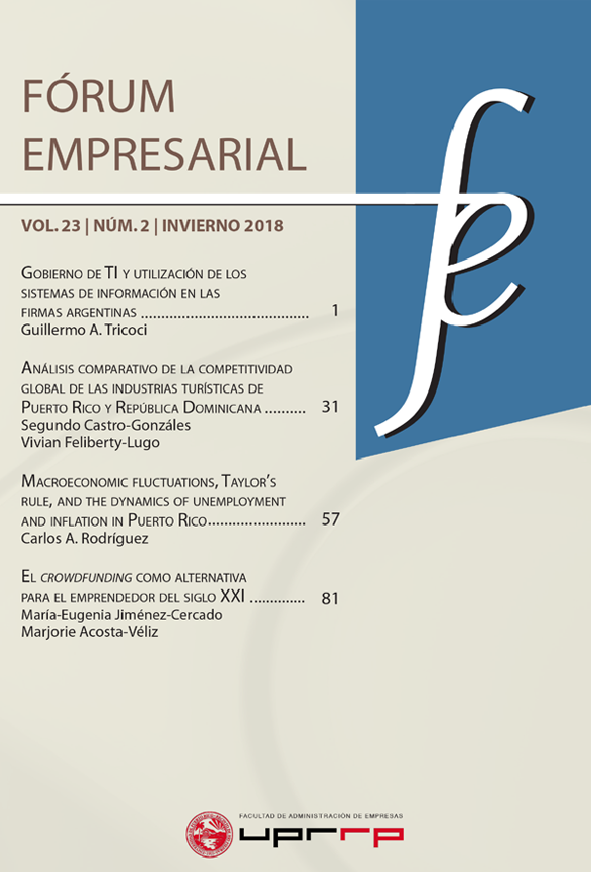Abstract
Through the structural decomposition developed by Blanchard and Quah (1989), this paper studies the effects of the impulses associated with the Taylor‘s rule of the United States and the supply and demand in Puerto Rico on the dynamics of the unemployment and inflation on the Island. According to the results, in the short run, unemployment responds mostly to the unanticipated shocks of the monetary policy rule in the United States and the supply shocks. Inflation also responds to this rule and the impulses associated with aggregate demand. In the long run, unemployment is declining, and inflation is accelerating mainly in the face of an unanticipated expansion of U.S. monetary policy caused by the establishment of the Taylor rule.References
Arnold, I. J. M (2001). The regional effects of monetary policy in Europe. Journal of Economic Integration, 16(3), 399–420.
Blanchard, O. J., & Quah, D. (1989). The dynamic effects of aggregate and demand disturbances. The American Economic Review, 79(4), 655–673.
Carlino, G., & Defina, R. H. (1998). The differential regional effects of monetary policy. The Review of Economics and Statistics, 80(4), 572–587.
Constitución del Estado Libre Asociado de Puerto Rico. (1947). Artículo VI [Título I]. Retrieved from http://www.lexjuris.com/lexprcont.htm
Dickey, D. A., & Fuller, W. A. (1981). Likelihood ratio statistics for autoregressive time series with a unit root. Econometrica, 49(4), 427–431.
Elder, J., & Kennedy, P. E. (2001). Testing for unit roots: What should students be taught? The Journal of Economic Education, 32(2), 137–146.
Enders, W. (1995). Applied econometrics time series. New York, NY: John Wiley & Sons.
Enders, W. (2003). RATS programming manual. Retrieved from https://tinyurl.com/y65kmbs9
Elliott, G., Rothenberg, T. J., & Stock, J. H. (1996). Efficient tests for an autoregressive unit root. Econometrica, 64(4), 813–836.
Fuller, W. A. (1976). Introduction to statistical time series. New York, NY: John Wiley & Sons.
Gobierno de Puerto Rico. (1976). Informe al Gobernador del comité para el estudio de las finanzas en Puerto Rico. Retrieved from https://tinyurl.com/y2gelvgy
Johansen, S. (1988). Statistical analysis of cointegrating vectors. Journal of Economic Dynamics and Control, 12, 231–254.
Karras, G. (1993). Sources of U.S. macroeconomic fluctuations. Journal of Macroeconomics, 15(1), 47–68.
Lucas, R. E. (1972). Expectations and the neutrality of money. Journal of Economic Theory, 4(2), 103–124.
Luciano Montalvo, I. (2005). Dependencia de la economía de Puerto Rico: Un análisis cuantatitavo y cualitativo de insumo-producto (1972-1987) (Doctoral dissertation). Universidad Nacional Autónoma de México, México.
Ludlow Wiechers, J. A., & León León, J. (2008). Efectos de la política monetaria sobre los precios, la producción y el empleo: México, 1986-2005. Investigación Económica, 67(266), 95–134.
Maddala, G. S., & Kim, M. (2002). Unit roots, cointegration and structural change. New York, NY: Cambridge University Press.
Mio, H. (2002). Identifying aggregate demand and aggregate supply components of inflation rate: A structural vector autoregression analysis for Japan. Monetary and Economic Studies, 20(1), 33–56.
Misas, M. A., & López-Enciso, E. A. (1999). El producto potencial en Colombia: Una estimación bajo un VAR estructural. Serie de Cuadernos de Investigación Centro de Estudios Monetarios Latinoamericanos (CEMLA), 1–36.
Nachane, D. M., Ray, P., & Ghosh, S. (2002). Does monetary policy have differential state-level effects? An empirical evaluation. Economic and Political Weekly, 37(47), 4723–4728.
Rao, B. (1994). Cointegration for the applied economist. London, United Kingdom: Palgrave Macmillan.
Rodríguez, C. A. (2002). Análisis de la economía de Puerto Rico con un modelo de vectores autorregresivos y cointegración. Revista de Ciencias Sociales, (11), 91–110.
Rodríguez, C. A. (2004). A P* model analysis of inflation in Puerto Rico. American Review of Political Economy, 2(2), 16–41.
Rodríguez, C. A. (2005). La estabilidad de la demanda real de dinero en Puerto Rico. Economics and Business Journal, 1(2), 39–56.
Rodríguez, C. A. (2006). The economic trajectory of Puerto Rico since WWII. Centro Journal, 17(2), 224–233.
Rodríguez, C. A. (2007). Efectos aceleradores reales de la política monetaria estadounidense sobre una economía pequeña, abierta y totalmente dolarizada: El caso de Puerto Rico. Revista de Ciencias Sociales, (16), 30–47.
Rodríguez, C. A. (2008). Evolución histórica, teoría económica y sistema deseable: Aspectos fundamentales en el progreso y desarrollo de Puerto Rico. Ensayos y Monografías, (136), 1–15.
Rodríguez, C. A. (2011). Credibilidad, pérdida social y estancamiento económico: El caso de Puerto Rico. Revista de Ciencias Sociales, (22), 1–19.
Rodríguez, C. A., & Ortiz, K. (2007). La tasa de los fondos federales de los Estados Unidos y la dinámica del mercado laboral en una economía pequeña, abierta y dolarizada: Evidencia mediante la creación y destrucción de empleo en Puerto Rico. Economics and Business Journal, 4(1), 85–112.
Rodríguez, C. A., & Toledo, W. (2007). Los efectos de la tasa de los fondos federales de los Estados Unidos en una economía pequeña, abierta y dolarizada: El caso de Puerto Rico. El Trimestre Económico, 74(293), 223–245.
Stock, J. H., & Watson, M. W. (2001). Vector autoregressions. Journal of Economic Perspectives, 15(4), 101–115.
Tapia, E., & Ramos, S. (2012). Impulsos de la demanda y oferta agregada y las fluctuaciones económicas en Santiago de Cali de 1996 a 2008. Tendencias, 13(1), 135–156.
Taylor, J. B. (1993). Discretion versus policy rules in practice. Carnegie-Rochester Conference Series on Public Policy, 39, 195–214. Retrieved from https://tinyurl.com/y2o9d759
Toledo, W. (1992) Sectoral shocks and economic fluctuations. Serie de Ensayos y Monografías, (62B), 1–18.
Toledo, W. (2000). Inflación y señoriaje en Puerto Rico. Serie de Ensayos y Monografías, (100), 1–15.
Toledo, W. (2002). El efecto de la política monetaria de Estados Unidos en la economía de Puerto Rico. Revista de Ciencias Sociales, (11), 73–90.
Toledo, W. (2014). Fuentes de fluctuaciones en América Latina Ecos de Economía, 18(38), 5–35.

This work is licensed under a Creative Commons Attribution-NonCommercial-ShareAlike 4.0 International License.
Copyright (c) 2018 Fórum Empresarial

